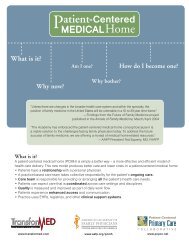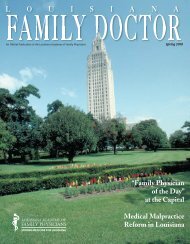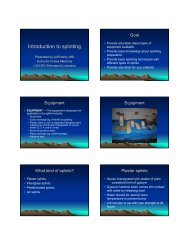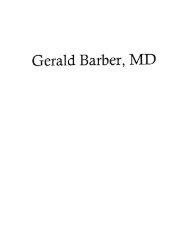New Drug Update 2009-2010 - LAFP
New Drug Update 2009-2010 - LAFP
New Drug Update 2009-2010 - LAFP
Create successful ePaper yourself
Turn your PDF publications into a flip-book with our unique Google optimized e-Paper software.
The AGREE (Acute Gout Flare Receiving Colchicine Evaluation) a mulitcenter, randomized, doubleblind,<br />
placebo-controlled, parallel-group study compared self-administered low-dose colchicine (1.8 mg total<br />
over 1 hour) and high-dose colchicine (4.8 mg total over 6 hours) with placebo. The primary end point<br />
was >50% pain reduction at 24 hours without rescue medication. Results: There were 184 patients in the<br />
intent-totreat analysis. Responders included 28 of 74 patients (37.8%) in the low-dose group, 17 of 52<br />
patients (32.7%) in the high-dose group, and 9 of 58 patients (15.5%) in the placebo group (P= 0.005 and<br />
P = 0.034, respectively versus placebo). Rescue medication was taken within the first 24 hours by 23<br />
patients (31.1%) in the low-dose group (P = 0.027 versus placebo), 18 patients (34.6%) in the high-dose<br />
group (P = 0.103 versus placebo), and 29 patients (50.0%) in the placebo group. The low-dose group had<br />
an adverse event (AE) profile similar to that of the placebo group, with an odds ratio (OR) of 1.5 (95%<br />
confidence interval [95% CI] 0.7–3.2). High-dose colchicine was associated with significantly more<br />
diarrhea, vomiting, and other AEs compared with low-dose colchicine or placebo. With high-dose<br />
colchicine, 40 patients (76.9%) had diarrhea (OR 21.3 [95% CI 7.9–56.9]), 10 (19.2%) had severe<br />
diarrhea, and 9 (17.3%) had vomiting. With low-dose colchicine, 23.0% of the patients had diarrhea (OR<br />
1.9 [95% CI 0.8–4.8]), none had severe diarrhea, and none had vomiting. (ARTHRITIS & RHEUMATISM<br />
Vol. 62, No. 4, April <strong>2010</strong>, pp 1060–1068)<br />
Based on this information, FDA is highlighting important safety considerations found in the approved<br />
prescribing information to assure safe use of Colcrys.<br />
FDA recommends:<br />
• Healthcare professionals not use P-glycoprotein (P-gp) or strong CYP3A4 inhibitors in patients<br />
with renal or hepatic impairment who are currently taking colchicine.<br />
• Healthcare professionals consider a dose reduction or interruption of colchicine treatment in<br />
patients with normal renal and hepatic function if treatment with a P-gp or a strong CYP3A4<br />
inhibitor is required.<br />
• Healthcare professionals prescribe the FDA-approved Colcrys dose for the treatment of acute<br />
gout flares: 1.2 mg followed by 0.6mg in 1 hour (total 1.8mg).<br />
• Healthcare professionals refer to Colcrys’ approved prescribing information for specific dosing<br />
recommendations and additional drug interaction information.<br />
• Patients review the Medication Guide for important safety information<br />
For treatment of prophylaxis of gout flares, the FDA recommended that patients taking an HIV drug<br />
combination cut their initial dose of colchicine by three-fourths, from 0.6 mg twice a day to 0.3 mg<br />
once a day, or, if they're taking 0.6 mg once a day, to 0.3 mg once every other day. For patients<br />
taking fosamprenavir calcium alone, cutting the colchicine dosage in half -- from 0.6 mg twice a day to<br />
0.3 mg twice a day, or from 0.6 mg once a day to 0.3 mg once daily -- is recommended.<br />
As a treatment for familial Mediterranean fever, the FDA recommended a maximum dose of 0.6 mg<br />
colchicine per day in patients taking both protease inhibitors and 1.2 mg daily in patients taking the<br />
single drug.<br />
November 2, <strong>2009</strong> FDA Alert Byetta (exenatide) – Renal Failure<br />
FDA notified healthcare professionals of revisions to the prescribing information for Byetta (exenatide) to<br />
include information on post-marketing reports of altered kidney function, including acute renal failure and<br />
insufficiency. Byetta, an incretin-mimetic, is approved as an adjunct to diet and exercise to improve<br />
glycemic control in adults with type 2 diabetes mellitus.<br />
From April 2005 through October 2008, FDA received 78 cases of altered kidney function (62 cases of<br />
acute renal failure and 16 cases of renal insufficiency), in patients using Byetta. Some cases occurred in<br />
patients with pre-existing kidney disease or in patients with one or more risk factors for developing kidney<br />
problems. Labeling changes include:<br />
• Information regarding post-market reports of acute renal failure and insufficiency, highlighting that<br />
Byetta should not be used in patients with severe renal impairment (creatinine clearance

















